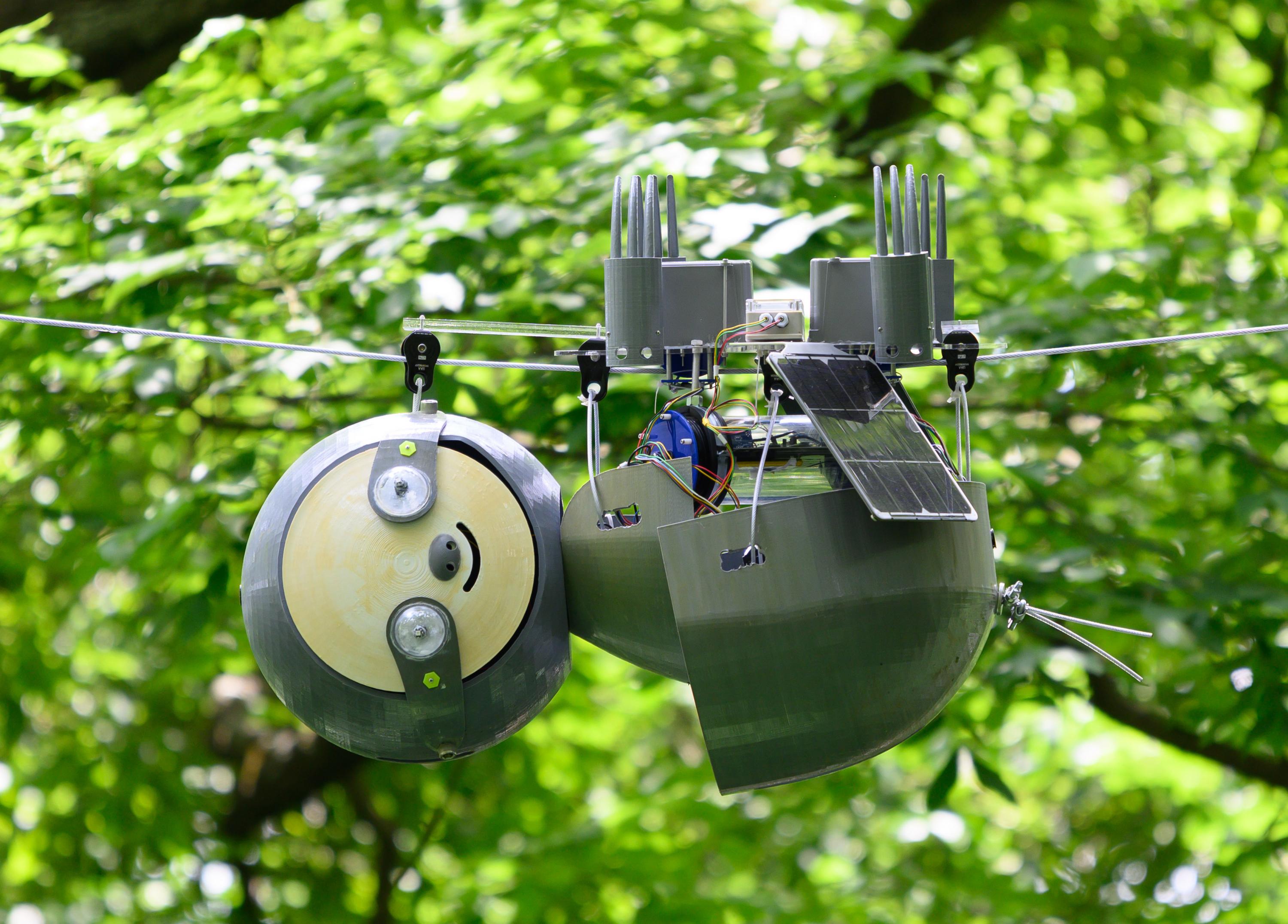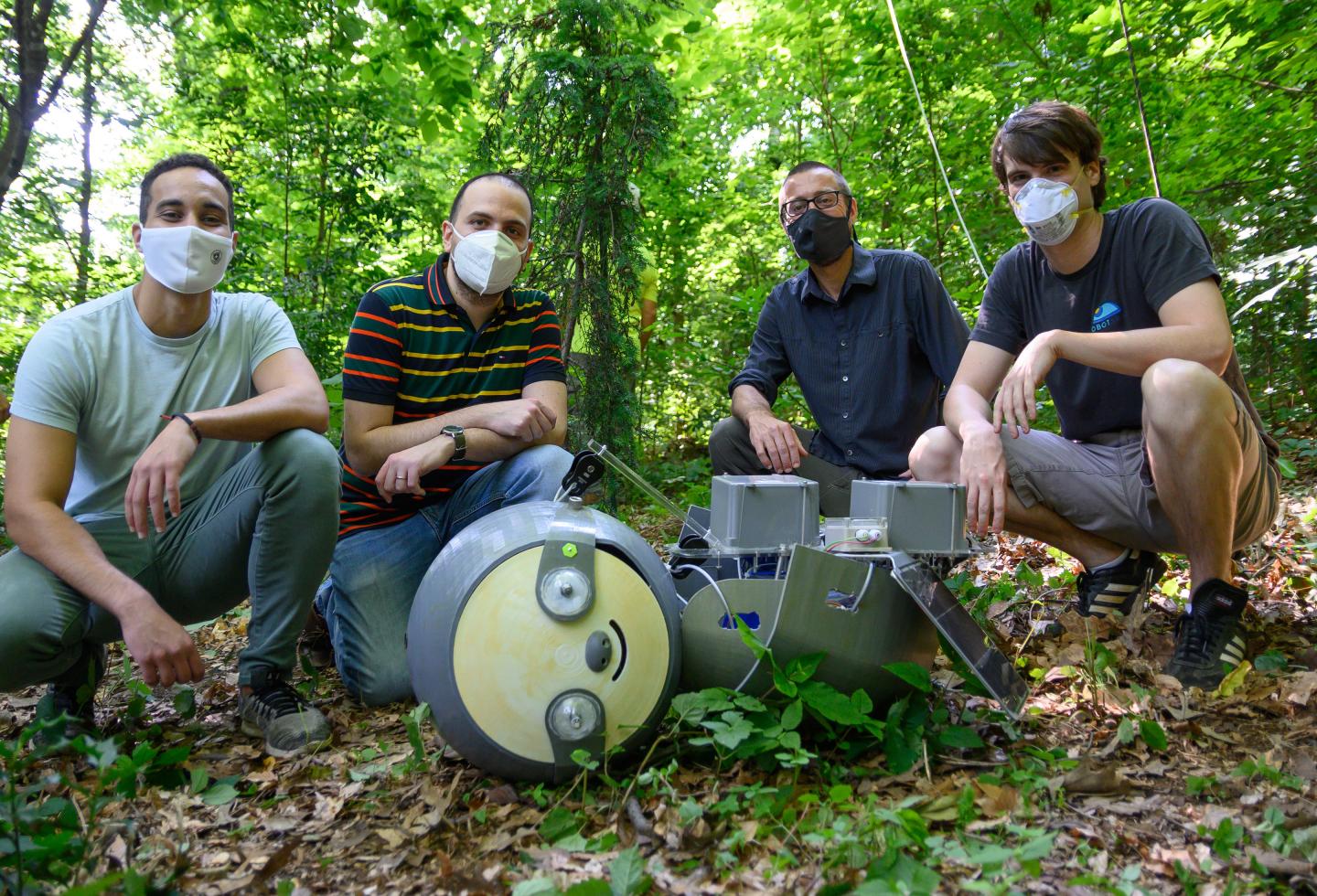In the Atlanta Botanical Garden, Georgia, visitors over the next several months will be treated to the peculiar sight of a sloth robot on a mission to save some of the world’s most endangered species.
Meet SlothBot, a new high-tech, a slow-moving and energy-efficient robot that can linger in the trees to monitor animals, plants, and the environment below. Featuring several 3D printed components, built by robotics engineers at the Georgia Institute of Technology, the SlothBot is currently being tested near the Garden’s popular Canopy Walk.
SlothBot has been designed to take advantage of the low-energy lifestyle of real sloths; it’s an example of how being slow can sometimes be ideal for certain applications. Powered by solar panels and using innovative power management technology, SlothBot moves along a cable strung between two large trees as it monitors the temperature, weather, carbon dioxide levels, and other information in the Garden’s 30-acre midtown Atlanta forest.
“SlothBot embraces slowness as a design principle,” explains Magnus Egerstedt, professor and Steve W. Chaddick School Chair in the Georgia Tech School of Electrical and Computer Engineering.
“That’s not how robots are typically designed today, but being slow and hyper-energy efficient will allow SlothBot to linger in the environment to observe things we can only see by being present continuously for months, or even years.”

Taking it slow with the SlothBot
The initial SlothBot prototype was designed by Egerstedt, alongside Ph.D. students Gennaro Notomista and Yousef Emam in 2019. The team used FDM 3D printed parts for the gearing and wire-switching mechanisms, which the robot needs to crawl through a network of wires in the trees.
Measuring three feet long, the new SlothBot in the Atlanta Botanical Garden also features a 3D printed shell, which helps to protect its motors, gearing, batteries, and sensing equipment from the weather. The robot is powered by a pair of photovoltaic panels and designed to linger in the forest canopy continuously for months, only moving when necessary to measure environmental changes. Such changes include weather and chemical factors, which can only be observed with a long-term presence. It will also move to locate sunlight when its batteries need recharging.
During its testing phase at the Atlanta Botanical Garden, SlothBot will operate on a single 100-foot cable, but in larger environmental applications, it will be able to switch from cable to cable to cover more territory.”The most exciting goal we’ll demonstrate with SlothBot is the union of robotics and technology with conservation,” said Emily Coffey, vice president for conservation and research at the Garden. “We do conservation research on imperiled plants and ecosystems around the world, and SlothBot will help us find new and exciting ways to advance our research and conservation goals.”

The SlothBot project is supported by the National Science Foundation and the Office of Naval Research. Researchers suggest that the robot has the potential to help scientists better understand the abiotic factors affecting critical ecosystems. It can, therefore, act as a new tool for developing information needed to protect rare species and endangered ecosystems.
“SlothBot could do some of our research remotely and help us understand what’s happening with pollinators, interactions between plants and animals, and other phenomena that are difficult to observe otherwise,” Coffey added. “With the rapid loss of biodiversity and with more than a quarter of the world’s plants potentially heading toward extinction, SlothBot offers us another way to work toward conserving those species.”
The design of the robot was inspired by a visit Egerstedt made to a vineyard in Costa Rica where he saw two-toed sloths creeping along overhead wires in their search for food in the tree canopy. “It turns out that they were strategically slow, which is what we need if we want to deploy robots for long periods of time,” he explained.
As well as conservation, the SlothBot could have applications for precision agriculture, where the robot’s camera and other sensory equipment could provide early detection of crop diseases, measure humidity, and watch for insect infestation. After testing in the Atlanta Botanical Garden, the researchers hope to move SlothBot to South America to observe orchid pollination or the lives of endangered frogs.
The research team, consisting of Gennaro Notomista and Yousef Emam, undergraduate student Amy Yao, and postdoctoral researcher Sean Wilson, considered multiple locomotion techniques for the SlothBot. Although wheeled robots are common, they are prone to a number of obstacles in the natural world like rocks or mud. At the other end of the spectrum, flying robots require too much energy to linger for long; hence Egerstedt’s observation of the wire-crawling sloths was so important.
“It’s really fascinating to think about robots becoming part of the environment, a member of an ecosystem,” he said. “While we’re not building an anatomical replica of the living sloth, we believe our robot can be integrated to be part of the ecosystem it’s observing like a real sloth.”

3D printing in the robot revolution
3D printing has played a significant role in designing various functional robots intended to help improve different facets of society. For example, last year scientists at Florida Atlantic University (FAU) used 3D printing deep learning, artificial intelligence, and robotics to create Astro, an intelligent robot dog that can see, hear, train, and learn. Potential applications for Astro include a number of useful tasks such as the detection of guns and explosives to assist police, the military, and security personnel. It can also be programmed to operate as a service dog for the visually impaired or provide medical diagnostic monitoring.
3D printing is also playing a key role in a NASA project seeking to bring soft robotics to space. Soft robots are constructed from highly flexible materials, allowing for new robot movements similar to living organisms that traditional robots can’t replicate, therefore presenting new possible applications for robots in space. Although in its early stages, 3D printing has played a key role in the research, having been used to develop the soft robotic actuator, which is key for animating and controlling a robot’s moving parts.
The nominations for the 2020 3D Printing Industry Awards are now open. Who do you think should make the shortlists for this year’s show? Have your say now.
Subscribe to the 3D Printing Industry newsletter for the latest news in additive manufacturing. You can also stay connected by following us on Twitter and liking us on Facebook.
Looking for a career in additive manufacturing? Visit 3D Printing Jobs for a selection of roles in the industry.
Featured image shows SlothBot in the Garden. Photo via Georgia Institute of Technology.


